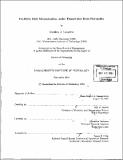Portfolio risk minimization under departures from normality
Author(s)
Lauprête, Geoffrey J. (Geoffrey Jean), 1972-
DownloadFull printable version (10.43Mb)
Other Contributors
Massachusetts Institute of Technology. Operations Research Center.
Advisor
Roy E. Welsch and Alexander Samarov.
Terms of use
Metadata
Show full item recordAbstract
This thesis revisits the portfolio selection problem in cases where returns cannot be modeled as Gaussian. The emphasis is on the development of financially intuitive and statistically sound approaches to portfolio risk minimization. When returns exhibit asymmetry, we propose using a quantile-based measure of risk which we call shortfall. Shortfall is related to Value-at-Risk and Conditional Value-at-Risk, and can be tuned to capture tail risk. We formulate the sample shortfall minimization problem as a linear program. Using results from empirical process theory, we derive a central limit theorem for the shortfall portfolio estimator. We warn about the statistical pitfalls of portfolio selection based on the minimization of rare events, which happens to be the case when shortfall is tuned to focus on extreme tail risk. In the presence of heavy tails and tail dependence, we show that portfolios based on the minimization of alternative robust measures of risk may in fact have lower variance than those based on the minimization of sample variance. We show that minimizing the sample mean absolute deviation yields portfolios that are asymptotically more efficient than those based on the minimization of the sample variance, when returns have a multivariate Student-t distribution with degrees of freedom less than or equal to 6. This motivates our consideration of other robust measures of risk, for which we present linear and quadratic programming formulations. (cont.) We carry out experiments on simulated and historical data, illustrating the fact that the efficiency gained by considering robust measures of risk may be substantial. Finally, when the number of return observations is of the same order of magnitude as, or smaller than, the dimension of the portfolio being estimated, we investigate the applicability of regularization to sample risk minimization. We examine both L1- and L2-regularization. We interpret regularization from a Bayesian perspective, and provide an algorithm for choosing the regularization parameter. We validate the use of regularization in portfolio selection on simulated and historical data, and conclude that regularization can yield portfolios with smaller risk, and in particular smaller variance.
Description
Thesis (Ph. D.)--Massachusetts Institute of Technology, Sloan School of Management, Operations Research Center, 2001. Includes bibliographical references (p. 206-210).
Date issued
2001Department
Massachusetts Institute of Technology. Operations Research Center; Sloan School of ManagementPublisher
Massachusetts Institute of Technology
Keywords
Operations Research Center.